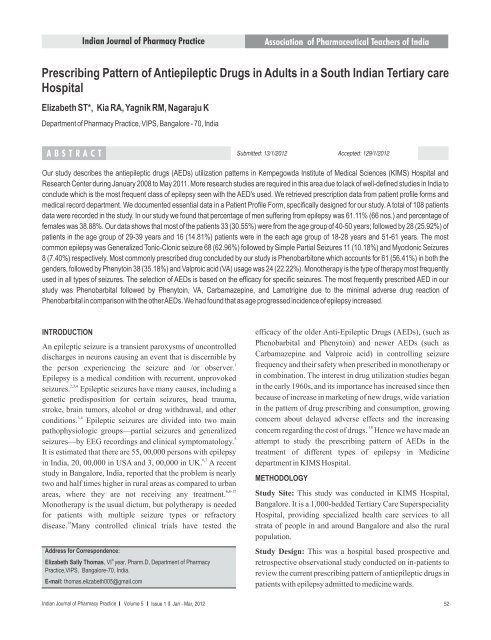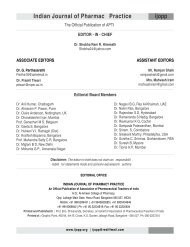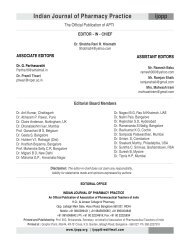Prescribing Pattern of Antiepileptic Drugs in Adults in a South Indian ...
Prescribing Pattern of Antiepileptic Drugs in Adults in a South Indian ...
Prescribing Pattern of Antiepileptic Drugs in Adults in a South Indian ...
Create successful ePaper yourself
Turn your PDF publications into a flip-book with our unique Google optimized e-Paper software.
<strong>Indian</strong> Journal <strong>of</strong> Pharmacy PracticeAssociation <strong>of</strong> Pharmaceutical Teachers <strong>of</strong> India<strong>Prescrib<strong>in</strong>g</strong> <strong>Pattern</strong> <strong>of</strong> <strong>Antiepileptic</strong> <strong>Drugs</strong> <strong>in</strong> <strong>Adults</strong> <strong>in</strong> a <strong>South</strong> <strong>Indian</strong> Tertiary careHospitalElizabeth ST*, Kia RA, Yagnik RM, Nagaraju KDepartment <strong>of</strong> Pharmacy Practice, VIPS, Bangalore - 70, IndiaA B S T R A C TSubmitted: 13/1/2012Accepted: 129/1/2012Our study describes the antiepileptic drugs (AEDs) utilization patterns <strong>in</strong> Kempegowda Institute <strong>of</strong> Medical Sciences (KIMS) Hospital andResearch Center dur<strong>in</strong>g January 2008 to May 2011. More research studies are required <strong>in</strong> this area due to lack <strong>of</strong> well-def<strong>in</strong>ed studies <strong>in</strong> India toconclude which is the most frequent class <strong>of</strong> epilepsy seen with the AED's used. We retrieved prescription data from patient pr<strong>of</strong>ile forms andmedical record department. We documented essential data <strong>in</strong> a Patient Pr<strong>of</strong>ile Form, specifically designed for our study. A total <strong>of</strong> 108 patientsdata were recorded <strong>in</strong> the study. In our study we found that percentage <strong>of</strong> men suffer<strong>in</strong>g from epilepsy was 61.11% (66 nos.) and percentage <strong>of</strong>females was 38.88%. Our data shows that most <strong>of</strong> the patients 33 (30.55%) were from the age group <strong>of</strong> 40-50 years; followed by 28 (25.92%) <strong>of</strong>patients <strong>in</strong> the age group <strong>of</strong> 29-39 years and 16 (14.81%) patients were <strong>in</strong> the each age group <strong>of</strong> 18-28 years and 51-61 years. The mostcommon epilepsy was Generalized Tonic-Clonic seizure 68 (62.96%) followed by Simple Partial Seizures 11 (10.18%) and Myoclonic Seizures8 (7.40%) respectively. Most commonly prescribed drug concluded by our study is Phenobarbitone which accounts for 61 (56.41%) <strong>in</strong> both thegenders, followed by Phenyto<strong>in</strong> 38 (35.18%) and Valproic acid (VA) usage was 24 (22.22%). Monotherapy is the type <strong>of</strong> therapy most frequentlyused <strong>in</strong> all types <strong>of</strong> seizures. The selection <strong>of</strong> AEDs is based on the efficacy for specific seizures. The most frequently prescribed AED <strong>in</strong> ourstudy was Phenobarbital followed by Phenyto<strong>in</strong>, VA, Carbamazep<strong>in</strong>e, and Lamotrig<strong>in</strong>e due to the m<strong>in</strong>imal adverse drug reaction <strong>of</strong>Phenobarbital <strong>in</strong> comparison with the other AEDs. We had found that as age progressed <strong>in</strong>cidence <strong>of</strong> epilepsy <strong>in</strong>creased.INTRODUCTIONAn epileptic seizure is a transient paroxysms <strong>of</strong> uncontrolleddischarges <strong>in</strong> neurons caus<strong>in</strong>g an event that is discernible by1the person experienc<strong>in</strong>g the seizure and /or observer.Epilepsy is a medical condition with recurrent, unprovoked2,3,4seizures. Epileptic seizures have many causes, <strong>in</strong>clud<strong>in</strong>g agenetic predisposition for certa<strong>in</strong> seizures, head trauma,stroke, bra<strong>in</strong> tumors, alcohol or drug withdrawal, and other3,4conditions. Epileptic seizures are divided <strong>in</strong>to two ma<strong>in</strong>pathophysiologic groups—partial seizures and generalized5seizures—by EEG record<strong>in</strong>gs and cl<strong>in</strong>ical symptomatology.It is estimated that there are 55, 00,000 persons with epilepsy6,7<strong>in</strong> India, 20, 00,000 <strong>in</strong> USA and 3, 00,000 <strong>in</strong> UK. A recentstudy <strong>in</strong> Bangalore, India, reported that the problem is nearlytwo and half times higher <strong>in</strong> rural areas as compared to urban6,8-17areas, where they are not receiv<strong>in</strong>g any treatment.Monotherapy is the usual dictum, but polytherapy is neededfor patients with multiple seizure types or refractory18disease. Many controlled cl<strong>in</strong>ical trials have tested theAddress for Correspondence:thElizabeth Sally Thomas, VI year, Pharm.D, Department <strong>of</strong> PharmacyPractice,VIPS, Bangalore-70, India.E-mail: thomas.elizabeth005@gmail.comefficacy <strong>of</strong> the older Anti-Epileptic <strong>Drugs</strong> (AEDs), (such asPhenobarbital and Phenyto<strong>in</strong>) and newer AEDs (such asCarbamazep<strong>in</strong>e and Valproic acid) <strong>in</strong> controll<strong>in</strong>g seizurefrequency and their safety when prescribed <strong>in</strong> monotherapy or<strong>in</strong> comb<strong>in</strong>ation. The <strong>in</strong>terest <strong>in</strong> drug utilization studies began<strong>in</strong> the early 1960s, and its importance has <strong>in</strong>creased s<strong>in</strong>ce thenbecause <strong>of</strong> <strong>in</strong>crease <strong>in</strong> market<strong>in</strong>g <strong>of</strong> new drugs, wide variation<strong>in</strong> the pattern <strong>of</strong> drug prescrib<strong>in</strong>g and consumption, grow<strong>in</strong>gconcern about delayed adverse effects and the <strong>in</strong>creas<strong>in</strong>g18concern regard<strong>in</strong>g the cost <strong>of</strong> drugs. Hence we have made anattempt to study the prescrib<strong>in</strong>g pattern <strong>of</strong> AEDs <strong>in</strong> thetreatment <strong>of</strong> different types <strong>of</strong> epilepsy <strong>in</strong> Medic<strong>in</strong>edepartment <strong>in</strong> KIMS Hospital.METHODOLOGYStudy Site: This study was conducted <strong>in</strong> KIMS Hospital,Bangalore. It is a 1,000-bedded Tertiary Care SuperspecialityHospital, provid<strong>in</strong>g specialized health care services to allstrata <strong>of</strong> people <strong>in</strong> and around Bangalore and also the ruralpopulation.Study Design: This was a hospital based prospective andretrospective observational study conducted on <strong>in</strong>-patients toreview the current prescrib<strong>in</strong>g pattern <strong>of</strong> antiepileptic drugs <strong>in</strong>patients with epilepsy admitted to medic<strong>in</strong>e wards.<strong>Indian</strong> Journal <strong>of</strong> Pharmacy Practice Volume 5 Issue 1 Jan - Mar, 2012 52
Elizabeth ST - <strong>Prescrib<strong>in</strong>g</strong> <strong>Pattern</strong> <strong>of</strong> <strong>Antiepileptic</strong> <strong>Drugs</strong> <strong>in</strong> <strong>Adults</strong> <strong>in</strong> a <strong>South</strong> <strong>Indian</strong> Tertiary care HospitalSample Size: A total <strong>of</strong> 108 In-patients from different units <strong>of</strong>medic<strong>in</strong>e department, who were on AEDs and fulfilled the<strong>in</strong>clusion criteria were selected and the rest <strong>of</strong> the patientswere excluded from the study, and the data were collected <strong>in</strong> awell designed performa.Study period: The retrospective study was conducted for aperiod <strong>of</strong> 36 months from January 2008 to December 2010.The prospective study was conducted for a period <strong>of</strong> sixmonths from January 2011 to May 2011.Study Criteria:1) Inclusion Criteria All adult In-patients who were treatedwith AEDs admitted <strong>in</strong> different units <strong>of</strong> Medic<strong>in</strong>eDepartment.2) Exclusion Criteria All pregnant women who are onAEDs.3) Source <strong>of</strong> Data: Data was collected us<strong>in</strong>g a well-designedpatient data collection form.1. By review<strong>in</strong>g the patient's treatment chart, case sheets <strong>of</strong>the patients.2. From the Medical Record Department <strong>of</strong> KIMS Hospitaland Research Centre.Preparation <strong>of</strong> data collection form: Information extractedfrom the case files will <strong>in</strong>clude: Demographic data, chiefcompla<strong>in</strong>t, If he/she is a known case <strong>of</strong> epilepsy and etiology<strong>of</strong> seizure, habits (Smoker/Alcoholic/food habits), adverseeffects, past medical history and past medication history,family history, laboratory details, diagnosis (provisional orconfirmatory). Treatment: AEDs prescribed and prescription<strong>of</strong> the AEDs by generic names. The recommended dosages <strong>of</strong>the AEDs were obta<strong>in</strong>ed from the patient case files anddischarge summary(ii) Statistical method.The data <strong>of</strong> each case file was collected and analyzed by apercentage method.4) Study procedure: After the Institutional EthicsCommittee approval a prospective and retrospective studywas conducted <strong>in</strong> KIMS Hospital and research centre to studythe prescrib<strong>in</strong>g patterns <strong>of</strong> AEDs <strong>in</strong> the treatment <strong>of</strong> epilepsy.RESULTSA retrospective and prospective study 108 epileptic patientswas undertaken to study the prescrib<strong>in</strong>g pattern <strong>of</strong> AED.The study <strong>in</strong>cluded 108 epileptic patients on antiepilepticsamong whom 66 (61.1%) patients were found to be male and42 (38.9%) patients were females.Majority <strong>of</strong> the patients 33 (30.55%) were <strong>in</strong> the age group <strong>of</strong>40-50 years, followed by 28 (25.92%) <strong>of</strong> 29-39 years and 16(14.81%) patients were <strong>in</strong> both age group <strong>of</strong> 18-28 years and51-61 years. About 15 (13.88%) patients were <strong>in</strong> the agegroup <strong>of</strong> 62 years and above. Our data shows that most <strong>of</strong> thepatients were from the age group <strong>of</strong> 40-50 years and majority<strong>of</strong> the enrolled patients were male as <strong>in</strong> the other studies.Fig. 1: Graphical representation <strong>of</strong> the distribution <strong>of</strong> 108epileptic patients based on the gender.Female: 38.88%Male: 61.11%Fig. 2: Graphical representation <strong>of</strong> distribution <strong>of</strong> agegroup with number <strong>of</strong> patients.Generalized Tonic-Clonic Seizures was found to be moreprevalent 68 (62.96%) patients out <strong>of</strong> which 41 were malesand 27 were female, followed by Simple Partial Seizures 11(10.18%), 07 were males and 04 were females. Total numbers<strong>of</strong> Myoclonic Seizures were 08 (7.40%) <strong>of</strong> which 07 malesand 01 female. Generalized Clonic Seizures 08 (7.40%) <strong>of</strong>which 01 was male and 07 female. In Complex PartialSeizures 06 (5.55%), 04 were male and 02 were female.Generalized Tonic Seizures <strong>of</strong> 04 (3.70%) patients, there wereonly male patients. In Atonic Seizures, a total <strong>of</strong> 03 (2.77%)patients <strong>of</strong> which 02 male and 01 female.Among all the prescriptions <strong>in</strong>clud<strong>in</strong>g drugs given<strong>in</strong>dividually, and <strong>in</strong> comb<strong>in</strong>ations, the usage <strong>of</strong>Phenobarbitone accounts for 61 (56.41%) patients <strong>of</strong> which<strong>Indian</strong> Journal <strong>of</strong> Pharmacy Practice Volume 5 Issue 1 Jan - Mar, 2012 53
Elizabeth ST - <strong>Prescrib<strong>in</strong>g</strong> <strong>Pattern</strong> <strong>of</strong> <strong>Antiepileptic</strong> <strong>Drugs</strong> <strong>in</strong> <strong>Adults</strong> <strong>in</strong> a <strong>South</strong> <strong>Indian</strong> Tertiary care HospitalFig. 3: Graphical representation <strong>of</strong> distribution <strong>of</strong> types <strong>of</strong>seizures among both the genders38 were male patients and 23 were female patients, followedby phenyto<strong>in</strong> 38 (35.18%) patients <strong>of</strong> whom 26 were malepatients and 12 were females. VA usage was 24 (22.22%)patients <strong>of</strong> which 18 were males and 08 were females.Fig. 4: Graphical representation <strong>of</strong> prescrib<strong>in</strong>g pattern <strong>of</strong>AEDs among both gendersCarbamazep<strong>in</strong>e usage was 18 (16.85 %) patients <strong>of</strong> which, 10were males and 08 were females. 03 (3%) <strong>of</strong> Lamotrig<strong>in</strong>e, 03patients were males and we did not have any female patientsrecorded.Age distribution <strong>of</strong> the patients with Generalized TonicClonic Seizures among both the genders: Out <strong>of</strong> 68 patients <strong>of</strong>Generalized Tonic Clonic Seizures majority were <strong>in</strong> the agegroup <strong>of</strong> 29-39 years, 18 (26.47%) patients, 11 were malesand 07 were females. 15 (22.05%) patients were <strong>in</strong> the agegroup <strong>of</strong> 40-50 years, 13 were males and 02 were females. 14(20.58%) patients were <strong>in</strong> the age group <strong>of</strong> 18-28 years, 07were males and 07 were females.11 (16.17%) patients were <strong>in</strong>the age group <strong>of</strong> 62 years and above, <strong>of</strong> which 04 were malesand 07 were females. 10 (14.70%) were <strong>in</strong> the age group <strong>of</strong> 51-61 years, 06 were males and 04 females.Age distribution <strong>of</strong> the patients with Simple PartialSeizures among both the genders: Out <strong>of</strong> 11 patients withsimple partial seizures 04 (36.36%) patients were <strong>in</strong> the agegroup <strong>of</strong> 29-39 years and 51-61 years, followed by 03(27.27%) patients were <strong>in</strong> the age group <strong>of</strong> 40-50years.Age distribution <strong>of</strong> the patients with Complex PartialSeizures among both the genders: Out <strong>of</strong> 06 patients withcomplex seizures 03 (50%) patients were <strong>in</strong> the age group <strong>of</strong>40-50 years, <strong>of</strong> which 02 were females and 01 was male,followed by 02 (33.33%) and 01 (16.66%) patient were <strong>in</strong> theage group <strong>of</strong> 29-39 years and 62 years and above respectively.Age distribution <strong>of</strong> the patients with Atonic Seizuresamong both the genders: Out <strong>of</strong> 03 patients with 02 (66.66%)patients were <strong>in</strong> the age group <strong>of</strong> 40-50 years, followed by 01(33.33%) patient was <strong>in</strong> the age group <strong>of</strong> 29-39 years.Age distribution <strong>of</strong> the patients with Myoclonic Seizuresamong both the genders: Out <strong>of</strong> 8 patients with MyoclonicSeizures 04 (50%) patients were <strong>in</strong> the age group <strong>of</strong> 29-39years, followed by 02 (25%) patients were <strong>in</strong> the age group <strong>of</strong>40-50 years, 01 (12.5%) patient each were <strong>in</strong> the age group <strong>of</strong>18-28 years and 51-61 years.Age distribution <strong>of</strong> the patients with Generalized ClonicSeizures among both the genders: Out <strong>of</strong> 08 patients withGeneralized Clonic Seizures 03 (37.5%) patients were <strong>in</strong> each<strong>of</strong> the age groups <strong>of</strong> 40-50years, and 62years above, followedby 01 (12.50%) patient each <strong>in</strong> the age group <strong>of</strong> 18-28 years,and 51-61 years.Age distribution <strong>of</strong> the patients with Generalized TonicSeizures among both the genders: Out <strong>of</strong> 04 patients withGeneralized Tonic Seizures 03 (75%) patients were <strong>in</strong> the agegroup <strong>of</strong> 40-50 years, followed by 01(25%) patient was <strong>in</strong> theage group <strong>of</strong> 18-28 years.DISCUSSIONWith the rise <strong>in</strong> the <strong>in</strong>cidence <strong>of</strong> epilepsy over the past yearsdevelopments <strong>of</strong> newer AEDs have entered <strong>in</strong>to the currentscenario. The advances <strong>in</strong> the therapeutical aspects <strong>of</strong>epilepsy and the efficacy <strong>of</strong> monotherapy versus comb<strong>in</strong>ationtherapy have not been extensively studied. The beneficialeffects <strong>of</strong> second generation drugs can also be studiedconduction Drug utilization studies <strong>in</strong> this area. In our studywe were able to make <strong>in</strong>ferences with regard to the mostcommonly prescribed AED's, most common types epilepsy,the different age group distribution, and the gender mostlikely affected. A total <strong>of</strong> 108 epileptic patients were <strong>in</strong>cluded.The <strong>in</strong>cidence <strong>of</strong> epilepsy was found to be higher <strong>in</strong> male than<strong>in</strong> females and also the <strong>in</strong>cidence <strong>of</strong> epilepsy <strong>in</strong>creases with an<strong>Indian</strong> Journal <strong>of</strong> Pharmacy Practice Volume 5 Issue 1 Jan - Mar, 2012 54
Elizabeth ST - <strong>Prescrib<strong>in</strong>g</strong> <strong>Pattern</strong> <strong>of</strong> <strong>Antiepileptic</strong> <strong>Drugs</strong> <strong>in</strong> <strong>Adults</strong> <strong>in</strong> a <strong>South</strong> <strong>Indian</strong> Tertiary care Hospital<strong>in</strong>crease <strong>in</strong> age. This <strong>in</strong>ference was supported by a study <strong>in</strong>28London conducted by Aidan Neligan. Another f<strong>in</strong>d<strong>in</strong>g weobserved <strong>in</strong> our study was that Phenobarbital was the mostfrequently prescribed drug followed by Phenyto<strong>in</strong> and VA.This drug utilization f<strong>in</strong>d<strong>in</strong>g was supported by two otherstudies conducted by Radhakrishnan K., Nayak S.D. et al. <strong>in</strong>Kerala and a study conducted by R.K Gupta and Pooja S.29-30Reddy. The above studies justified the use <strong>of</strong>Phenobarbital because it was the equally effective as otherAEDs when used <strong>in</strong> monotherapy, very less <strong>in</strong>cidences <strong>of</strong>adverse drug reactions (ADR) and also the cost was leastwhen pharmacoeconomics evaluation (Cost M<strong>in</strong>imizationAnalysis) was conducted. Our study had certa<strong>in</strong> limitation, asour center is not a referral center for neurology; hence we hadlimited number <strong>of</strong> sample size for our study. Our studyembarks to conduct a prospective study for about two years toaccess the quality <strong>of</strong> life <strong>of</strong> the epileptic patients, along withthis we can also <strong>in</strong>clude monitor<strong>in</strong>g <strong>of</strong> adverse effects <strong>of</strong> allAED's, long term medication adherence and thereby control<strong>of</strong> seizures, pharmacoeconomics evaluations and repeatedhospitalization due to recurrent episodes <strong>of</strong> epilepsy.CONCLUSIONMonotherapy is the type <strong>of</strong> therapy most frequently used <strong>in</strong> alltypes <strong>of</strong> seizures. The selection <strong>of</strong> AEDs is based on efficacyfor specific seizure types and epileptic syndromes. Mostcommonly prescribed drug concluded by our study isPhenobarbitone followed by Phenyto<strong>in</strong> and VA usage Weobserved that most <strong>of</strong> the patients had Generalized TonicClonic Seizures followed by Simple Partial Seizures andMyoclonic Seizures. The percentage <strong>of</strong> men suffer<strong>in</strong>g fromepilepsy was higher than females. Our data shows that most <strong>of</strong>the patients were from the age group <strong>of</strong> 40-50 years.ACKNOWLEDGMENTSThe authors wish to thank all the faculty members <strong>of</strong> medic<strong>in</strong>edepartment, KIMS Hospital and Research Centre, theMedical Record Department (MRD) staff, KIMS hospital andResearch Centre for their k<strong>in</strong>d cooperation <strong>in</strong> issu<strong>in</strong>g themedical reports. We also extend our s<strong>in</strong>cere gratitude to all thefaculty <strong>of</strong> Department <strong>of</strong> Cl<strong>in</strong>ical Practice, V.I.P.S for hervaluable guidance. We extend our heartfelt thankfulness tothe Pr<strong>in</strong>cipal, V.I.P.S for this timely support to complete thiswork.REFERENCES:1. Dhillon S, Sander JW. Epilepsy. In: Walker R, Edwards C,rdeditor. Cl<strong>in</strong>ical Pharmacy and Therapeutics. 3 ed. Scotland:Churchill liv<strong>in</strong>g stone; 2003; 465-466.2. Helms, Quan, Herf<strong>in</strong>dal, Gourley. Textbook <strong>of</strong> therapeuticsdrug and disease management 8th ed., pg. nos. 1609, 1611.3. Jose E. C. Seizures and Epilepsy, Overview and classification,http://emedic<strong>in</strong>e.medscape.com/article/1184846-overview.4. A Manual for Physicians, World Health Organization (WHO),Regional Office for <strong>South</strong>-East Asia, New Delhi. Epilepsy: pg.nos. 9, 15, 16.5. Gidal BE ,Garnett RW. Epilepsy. In: Dipiro JT, Talbert RL, et al.theditor. Pharmacotherapy, a pathophysiological approach. 6ed. NewYork:Mcgraw-hill medical publish<strong>in</strong>g division; 2005.6. Sridharan R., Epidemiology <strong>of</strong> Epilepsy, Current Sciences, Vol.82, No. 6, 2002 March 25th, pg. nos. 664-670.7. Arulkumaran K.S.G. et al., A study on the drug use evaluation <strong>of</strong>ADEs at multispecialty Tertiary Care Teach<strong>in</strong>g Hospital.International Journal <strong>of</strong> Pharm. Tech. Research Coden (USA),Vol. 1 (4), 2009 Oct-Dec, pg. nos. 1541-1547.8. Pond, D, Bidwell, B. and Ste<strong>in</strong>, L., Psychiatr. Neurol.Neurolchir., 1960, Vol. 63. pg. nos. 217-236.9. Krohn, W. A., Acta Psychiatr. Scand., 1961, Vol. 36 pg. nos.215-225.10. Sato, S., Cl<strong>in</strong>. Neurol. (Tokyo), 1964, Vol. 4, pg. nos. 313-324.11. Juul-Jensen. P. and Foldspang, A., Epilepsia, 1983, Vol. 24, pg.nos. 297-312.12. Granieri, E., Rosati, G., Tola, R., Pavoni, M., Paol<strong>in</strong>o, E., P<strong>in</strong>na,L. and Monetti, V. C. ibid, 1985, Vol. 24, pg. nos. 502-514.13. Mani K. S. Neurosci. Today, 1997, Vol. 1, pg. nos. 167-174.14. Guberman, A. H. and Bruni, J., Essentials <strong>of</strong> Cl<strong>in</strong>ical Epilepsy,Butterworth He<strong>in</strong>emann, Boston, 1999, 2nd ed., pg. nos. 3-10.15. Cockerell, O. C. and Shorvon, S. D., Epilepsy CurrentsConcepts, Current Medical Literature Ltd., London, 1996, pg.nos. 1-13.16. Placencia, M., Shorvon, S. D., Paredes, V., Bimos, C., Sander,J. W., Suarez, J. and Cascante, S. M., Bra<strong>in</strong>, Vol. 115 1992, pg.nos. 771-782.17. Hauser, W. A., Annegers, J. F. and Kurland, L. T., Epilepsia,1993, Vol. 34 pg. nos. 453-468.18. Shobhana Mathur, Sumana Sen et al., Asian Journal Utilization<strong>Pattern</strong> <strong>of</strong> AEDs and their adverse effects, <strong>in</strong> a Teach<strong>in</strong>gHospital, Vol. 3(1), 2010 January-March, pg. nos. 55-59.19. G. Parthasarathi, Kar<strong>in</strong> Nyfort-Hansen, Milap C. Nahata, Atextbook <strong>of</strong> Cl<strong>in</strong>ical Pharmacy Practice, 1st ed., pg. no. 362.20. Shih-Hui, Eng-K<strong>in</strong>g and Christopher, <strong>Pattern</strong> <strong>of</strong> AEDs usage <strong>in</strong>a tertiary referral hospital <strong>in</strong> S<strong>in</strong>gapore, Department <strong>of</strong><strong>Indian</strong> Journal <strong>of</strong> Pharmacy Practice Volume 5 Issue 1 Jan - Mar, 2012 55
Elizabeth ST - <strong>Prescrib<strong>in</strong>g</strong> <strong>Pattern</strong> <strong>of</strong> <strong>Antiepileptic</strong> <strong>Drugs</strong> <strong>in</strong> <strong>Adults</strong> <strong>in</strong> a <strong>South</strong> <strong>Indian</strong> Tertiary care HospitalNeurology, S<strong>in</strong>gapore, Neurol. Journal. <strong>South</strong>east Asia 1997,pg. nos. 77-85.21. Alessandro O. et al., <strong>Prescrib<strong>in</strong>g</strong> <strong>Pattern</strong> <strong>of</strong> AEDs <strong>in</strong> Italiansett<strong>in</strong>g elderly outpatients: a population-based study dur<strong>in</strong>g2004-07. British Journal <strong>of</strong> Cl<strong>in</strong>ical Pharmacology, Vol. 70,2010 October, pg. nos. 514-522.22. Hanssens Y., Deleu D., Al Balushi, et al. Drug utilization pattern<strong>of</strong> AEDs: A pharmacoepidemiological study <strong>in</strong> Oman. Journal <strong>of</strong>Cl<strong>in</strong>ical Pharmacy and Therapeutics, Vol. 27, 2002 October,(5), pg. nos. 357-364.23. Tsiropoulos I, Gichangi A., Andersen M., et al. Trends <strong>in</strong>utilization <strong>of</strong> AEDs <strong>in</strong> Denmark. Acta Neurol. Scand., 2001 July,pg. nos. 6-1124. Rochat P., Hallas J., Gaist D., et al. AEDs utilization: A Danishprescription database analysis. Epilepsy Res. 2009 Jan 9th,pg. no. 21.25. Pugh, Mary, Foreman et al., <strong>Prescrib<strong>in</strong>g</strong> AEDS for elderly:Difference between Guidel<strong>in</strong>e recommendations and cl<strong>in</strong>icalpractice, Acta Neurol Scand 2006, pg. no. 405.26. Joseph T. Dipiro et al., Pharmacotherapy, A Pathophysiologicalapproach, 5th ed., pg. no. 1023.27. Kasper, Braunwald, Fauci et al., Harrison's pr<strong>in</strong>ciples <strong>of</strong>Internal Medic<strong>in</strong>e, 16th ed., vol. II, pg. 2357.28. Neligan A., The <strong>in</strong>cidence and prevalence <strong>of</strong> epilepsy, Nationalgeneral practice study <strong>of</strong> epilepsy, 2009, Vol II, pg.2.29. Radhakrishnan K, Nayak SD, Kumar SP, Sarma PS. Pr<strong>of</strong>ile <strong>of</strong>antiepileptic pharmacotherapy <strong>in</strong> a tertiary referral center <strong>in</strong>S o u t h I n d i a : a p h a r m a c o e p i d e m i o l o g i c a n dpharmacoeconomic study. Epilepsia, 1999; vol. 40, pg. no.179-185.30. R. K. Gupta, Pooja S. Reddy. A calm look on cost analysis <strong>of</strong>different brands <strong>of</strong> anti-epileptic drugs, J MGIMS, Mar<strong>Indian</strong> Journal <strong>of</strong> Pharmacy Practice Volume 5 Issue 1 Jan - Mar, 2012 56
















